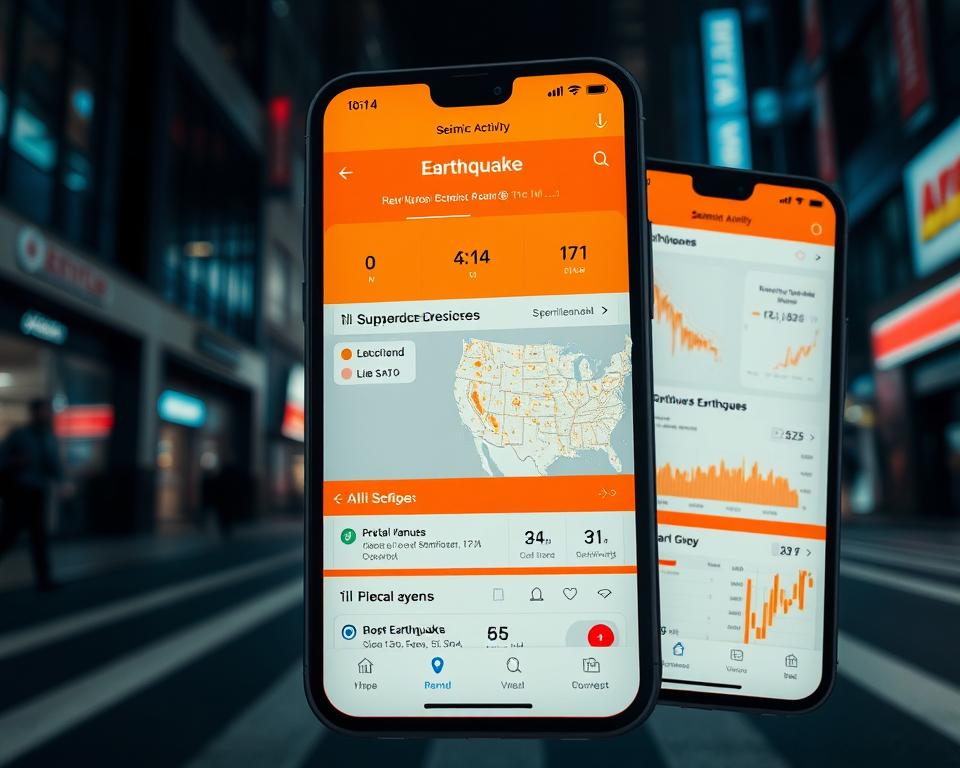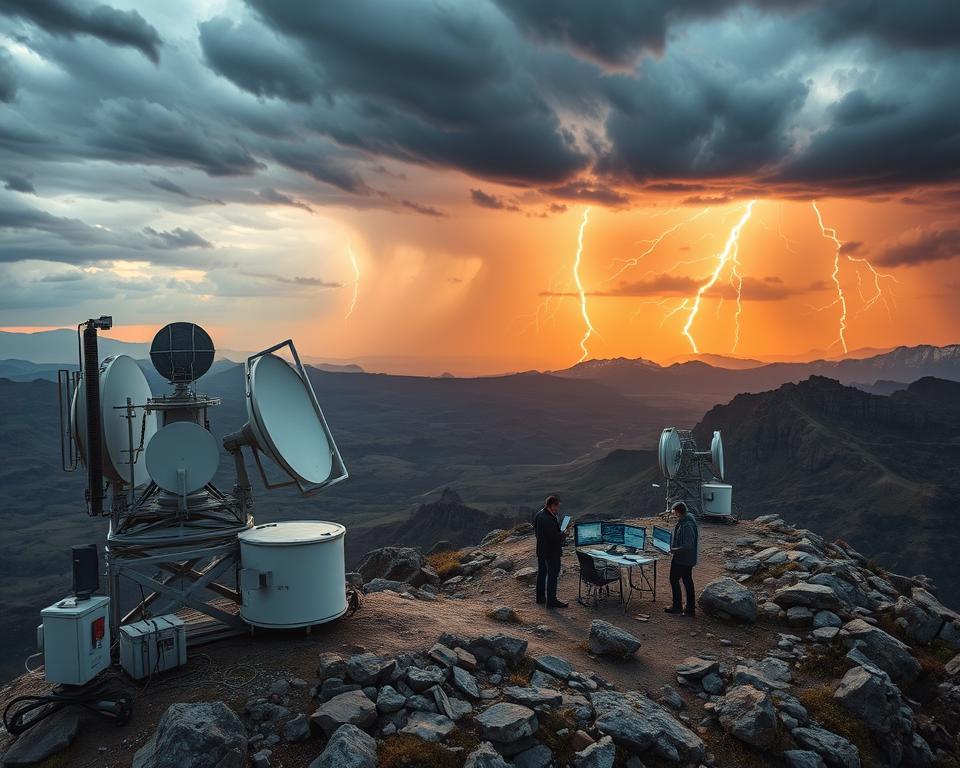Advertisements
Have you ever wondered how to know when an earthquake is going to happen? Apps like Earthquake, Earthquake and Earthquake+ send notifications right away. They use data from USGS and EMSC on interactive maps.
With the help of technology, even the MyShake achieves 93% accuracy. This makes your smartphone a real tremor detector. This way, you will know before the earthquake happens.
Advertisements

Main points
- Real-time alerts with data from institutions such as INGV and EMSC.
- Interactive maps showing the location and magnitude of earthquakes.
- Push notifications to warn of potential earthquakes before they occur.
- Customize alerts for your region and preferences.
- Detection technology proven by scientific studies.
Introduction: The importance of seismic forecasting

Earthquakes can cause unforeseen damage. But the earthquake prediction provides a crucial warning window. Modern systems use data from accelerometers in cell phones and institutions such as USP and UNB to analyze ground movements.
This helps predict tremors before they occur, giving you time for urgent action.
What is seismic forecasting?
This technique uses scientific data to identify patterns that anticipate tremors. Equipment monitors microtremors and ground deformations, combining information from global seismographic networks.
THE earthquake prediction does not predict the exact date. But it calculates risks based on geological evidence.
How technology can save lives
Advanced apps and sensors turn raw data into actionable alerts. Here’s how it works:
- Sensors in cell phones detect movements in milliseconds
- Systems like the USGS analyze data in real time
- Direct notifications to users near the risk area
These methods reduce late reactions. Check out the evolution:
Traditional Method Modern Technology Manual chart analysis Automated algorithms Alerts took hours Notifications in seconds via apps Regional coverage Real-time global monitoring
The combination of science and innovation makes the earthquake prediction a vital tool. With these technologies, you can be prepared before the ground shakes.
How does the app that shows when an earthquake is going to happen work?
Imagine having access to information about earthquakes before they hit your area. Apps like MyShake and the system ShakeAlert use the seismic prediction technology. They turn your smartphone into a motion detector. The earthquake tracking is done with sensors on your phone, such as accelerometers. These sensors identify initial vibrations of tremors.
Main features
These apps analyze data from thousands of seismographic devices and stations in real time. Here's how it works:
- Cell phone sensors detect P (primary) waves, which precede destructive waves;
- Central servers process the data to calculate magnitude and location;
- Alerts are sent to users before the tremor hits.
“MyShake can identify an earthquake up to 10 seconds before it starts, giving you crucial time to protect yourself.” – BBC
User-friendly interface and notifications
The app's interface is designed to simplify access to information. When you open the app, you see:
- Interactive maps with epicenter points and magnitude in real time;
- Customizable notifications by region or tremor intensity;
- Quick explanations on how to act during the event.
This combination of earthquake tracking with an intuitive interface ensures you have accurate data and practical recommendations whenever you need them.
App Features and Earthquake Alerts
The app uses smartphone sensors to give earthquake alerts in real time. Android, for example, turns your phone into a mini-seismograph. It captures vibrations with accelerometers. This information is sent to servers that check for tremors.
- Instant notifications based on data from institutions such as INGV and EMSC;
- Interactive maps with location and magnitude of tremors;
- Customized safety guidelines for your region.
To work well, the app needs the help of users. The more devices participate, the more accurate the earthquake alert. However, systems like the one in Japan, which use geological sensor networks, are more reliable. In Brazil, the lack of fixed infrastructure can cause false alerts, as in Ubatuba (SP) in 2025. But the app is still useful for preparing, if combined with basic security knowledge.
For added security, turn on notifications and always check for official updates. Remember: a earthquake alert can be crucial. A few seconds can save lives.
Earthquake notifications and tracking
THE earthquake monitoring It's easier with personalized alerts. You can choose to receive notifications only when an earthquake hits your area or reaches a specific magnitude. Apps like Earthquake+ allow you to filter data by location and intensity. USP Earthquake uses user reports to update in real time.
Customizing alerts
With the earthquake monitoring, you can set preferences. For example:
- Notifications by magnitude (e.g. ≥5.0 on the Richter scale)
- Geolocalized alerts for your city or chosen regions
- Customizable sound and vibration options
Integration with mobile devices
On iOS, apps like Earthquake and Earthquake have interactive maps and widgets on the home screen. On Android, the earthquake monitoring uses cell phone sensors to detect vibrations. This sends alerts before the shock.
For those who use iPhone, the Earthquake in the App Store allows you to export data to spreadsheets. This helps with analysis. USP Earthquake Free accepts user reports to improve accuracy. Keep the app updated and set up notifications to ensure safety.
Seismic prediction technology and future updates
The systems of earthquake notification use artificial intelligence. They analyze geophysical patterns. The ShakeAlert in the US sends alerts in seconds, using neural networks.
In Brazil, the National Observatory works with the Brazilian Seismographic Network (RSBR). They seek to improve local calibration.
- Current challenges: Short time for analysis and reduction of false alerts.
- Solutions under development: Denser sensors and algorithms adapted to Brazilian terrain.
In 2025, a false alert on the coast of São Paulo showed the need for regional adjustments. Google has already temporarily disabled systems in Brazil to recalibrate models, prioritizing accuracy. Institutions such as the Pacific Tsunami Warning Center (PTWC) integrate data from satellites and ocean sensors for more reliable forecasts.
“Improve the earthquake notification requires global collaboration and local adjustments.” — PTWC Report, 2023
Future updates will include:
- Real-time data integration from sensor networks.
- Geolocalized notifications for specific risk areas.
With advances in AI and international partnerships, the goal is to reduce gaps between detection and alert. Systems like the one from University of Tokyo inspire models adaptable to Brazil. Thus, the earthquake notifications will be more accurate and useful to you and your community.
Tips for preparing for and responding to an earthquake
Preparing for an earthquake can save lives. earthquake warning service from Google, on Android devices, detects seismic events and warns in advance. See the essential actions for your safety:
- Before the tremor: Talk to your family about emergency plans. Find safe spots in your home, such as doorways or corners of walls. Prepare a emergency kit with water, non-perishable food and medical items.
- During the earthquake: If you are at home, hide under a table. Avoid windows and heavy furniture. If you are driving, park your car in an open area and stay in the vehicle.
- After the tremor: turn off gas and electricity. Be alert for aftershocks and follow the instructions of authorities via radio or notifications.
Security measures
Practice simulation exercises with your family. Secure large pieces of furniture to the wall and store fragile objects on lower shelves. earthquake warning service Google's P-wave detection system alerts users up to seconds before the tremor. Activate the function in your smartphone's settings.
Emergency preparedness
Include in your kit: flashlight, radio, N95 mask and cash. In February 2025, Anatel clarified that Google alerts do not replace official systems, but complement personal preparation.
Prepare calmly and keep the app updated. Every second counts!
Conclusion
Have a earthquake prediction app on your cell phone can save lives. Apps like USP Earthquake allow reporting tremors. The Earthquake Alert warns before an earthquake. They are essential tools.
They use advanced technology to monitor seismic activity in real time. For example, the Earthquake Network turns your phone into a global sensor.
These apps not only warn you, but also teach you how to act. You can customize alerts and see maps with epicenters and magnitude. Earthquake+ and the SkyAlert give safety tips, such as protecting yourself under tables.
Remember: preparation is key. Download one of these apps today and set up notifications. Knowing when and where an earthquake is likely to strike gives you time to act quickly, so you and your loved ones stay safe.
FAQ
What is the app that shows when there is going to be an earthquake?
How does earthquake prediction work?
What types of notifications does the app offer?
Is it possible to customize the app's alerts?
How can seismic forecasting technology save lives?
Is the app easy to use?
What data sources are used to predict earthquakes?
What are the recommended safety measures during an earthquake?
Source Links
- https://apps.apple.com/br/app/terremoto/id534494328
- https://apps.apple.com/br/app/earthquake/id632040358
- https://apps.apple.com/br/app/terremoto-alertas-mapa-info/id395928613
- https://www.bbc.com/portuguese/noticias/2016/02/160217_app_detector_terremoto_rb
- https://www.ingv.it/it/; https://www.emsc-csem.org/
- https://www.bbc.com/portuguese/articles/clyw1gyndxeo
- https://www.estadao.com.br/brasil/alerta-de-terremoto-no-celular-entenda-como-funciona-sistema-google-nprm/
- https://www.hardware.com.br/artigos/sistema-alerta-terremotos-brasil/
- https://www.bbc.com/portuguese/noticias/2013/07/130710_terremoto_smartphones_fn
- https://sismo.iag.usp.br/app
- https://canaltech.com.br/apps/como-funciona-o-alerta-de-terremotos-do-android/
- https://www.nexxant.com.br/post/tecnologias-de-deteccao-e-alerta-de-terremotos-e-tsunamis-o-caso-do-caribe-e-o-futuro-da-prevencao
- https://www.bbc.com/portuguese/noticias/2010/01/100114_haitialerta2ebc
- https://www.gov.br/observatorio/pt-br/assuntos/noticias/observatorio-nacional-esclarece-falso-alerta-de-terremoto-emitido-pelo-google
- https://www.aterratreme.pt/os-7-passos/
- https://moho.iag.usp.br/app
- https://fabricadecurso.com/aplicativos-para-detectar-terremotos/
- https://truzes.com/799/os-5-melhores-aplicativos-para-medir-terremotos/



